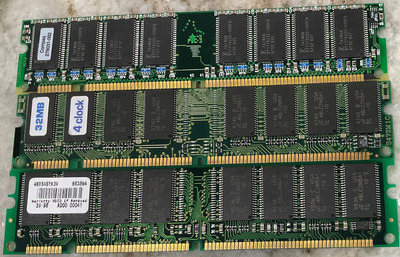Repo Man11 wrote on 2022-05-13, 18:37:"The Intel VX doesn't have enough Memory Address lines to drive the higher integration DRAM technology, be it EDO or SDRAM. 16-M […]
Show full quote
"The Intel VX doesn't have enough Memory Address lines to drive the higher integration DRAM technology, be it EDO or SDRAM. 16-MBit is the highest density supported, while the parts on a 64-MByte EDO SIMM are 64-MBit (eight chips)
Do the math - count the SDRAM chips on your DIMM (the large ones) [if they're ECC DIMMs, round down to the nearest power of two], and compute:
((total capacity in MByte)*8)/(number of chips)
The result is the density in MBit of the SDRAM components used.
Examples:
32-MByte DIMM with 16 chips: 32*8/16=16, usable with Intel VX.
128-MByte ECC DIMM with 18 chips - round down to 16, 128*8/16 = 64, not usable on VX.
As current production is 64- or 128-MBit densities, the bottom line of all this is that SDRAM support in Intel VX is useless with today's DIMMs.
Also, in order to have your board recognize 32Mb per DIMM, you'll need the 16-chip versions. If you have the 8-chip version, only 8Mb (your case) will be recognized.
Remember, it's not a memory problem; it's a chipset limitation. And no, this can't be fixed by a BIOS update."
https://web.archive.org/web/20060209035056/ht … w.wimsbios.com/
Thanks a lot for providing some assistance, I really appreciate it!
Perhaps I didn't phrase my issue correctly:
A - I do know it's not a memory problem - all the modules work elsewhere.
B - I do know a BIOS update will not address the issue.
C - I do know the VX Chipset has limitations - that's my problem. What modules will be compatible? Counting the chips doesn't seem to work.
D- I also have a feeling ECS, unless there is a malfunction, took some kind of goofball shortcut to staple SDRAM onto this board just to advertise it has support. Finding a compatible L2 cache module wasn't easy, either.
I've attached 3x 16-chip 32MB modules - None of them work in this motherboard (the bottom 2 have the same chip types, it appears; maybe different revisions?). From here, I don't know where else to go to find the right modules for this motherboard. I'm at or have exceeded my "RAM" expertise limitations. Is there a data sheet I should be reviewing and looking for specific chips, which "should" be compatible with VX?
Maybe this one will work? I'm only basing this on its simple design, only 4 chips, limited to a single side - nothing rational as I don't have that level of knowledge at this time.
https://www.ebay.com/itm/143993121397?epid=1300249936
